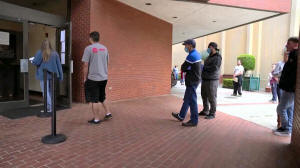U.S. weekly jobless claims drop below 500,000; layoffs lowest since 2000
 Send a link to a friend
Send a link to a friend
 [May 07, 2021] By
Lucia Mutikani [May 07, 2021] By
Lucia Mutikani
WASHINGTON (Reuters) - The number of
Americans filing new claims for unemployment benefits fell below 500,000
last week for the first since the COVID-19 pandemic started more than a
year ago, signaling the labor market recovery had entered a new phase
amid a booming economy.
That was reinforced by other data on Thursday showing U.S.-based
employers in April announced the fewest job cuts in nearly 21 years. The
reports added to other upbeat employment data in suggesting that the
economy enjoyed another blockbuster month of job growth in April.
But the labor market is not out of the woods yet, with about 16.2
million people still collecting unemployment checks.
"Although unemployment remains elevated, the labor market is rapidly
recovering," said Gus Faucher, chief economist at PNC Financial in
Pittsburgh, Pennsylvania.

Initial claims for state unemployment benefits tumbled 92,000 to a
seasonally adjusted 498,000 for the week ended May 1, the Labor
Department said. That was the lowest since mid-March 2020, when
mandatory shutdowns of nonessential businesses were enforced to slow the
first wave of COVID-19 infections.
Economists polled by Reuters had forecast 540,000 applications for the
latest week. The decline in claims was led by Virginia, Florida, New
York and California.
The government has provided nearly $6 trillion in pandemic relief over
the past year. Americans over the age of 16 are now eligible to receive
the COVID-19 vaccine, leading states like New York, New Jersey and
Connecticut to lift most of their coronavirus capacity restrictions on
businesses.
The massive fiscal stimulus and rapidly improving public health
situation are unleashing pent-up demand, resulting in a scramble for
workers by companies.
Reports on Wednesday showed private employers hired the most workers in
seven months on April, while a measure of services industry jobs rose to
more than a 2-1/2-year high. Consumers' perceptions of the labor market
are the strongest in 13 months.
Stocks on Wall Street were trading mostly lower, led by vaccine makers
after President Joe Biden announced plans to back intellectual property
waivers on COVID-19 shots. The dollar fell against a basket of
currencies. U.S. Treasury prices rose.
PRODUCTIVITY REBOUNDS
In a separate report on Thursday, global outplacement firm Challenger,
Gray & Christmas said layoffs announced by U.S.-based employers fell 25%
in April to 22,913, the fewest since June 2000. Planned layoffs so far
this year are down 84% from the same period in 2020.
According to a Reuters survey of economists, nonfarm payrolls likely
increased by 978,000 jobs last month after rising by 916,000 in March.
That would leave employment about 7.5 million jobs below its peak in
February 2020.
Estimates range from as low as 656,000 to as high as 2.1 million jobs.
The Labor Department will publish April's employment report on Friday.
[to top of second column] |

Initial claims for state unemployment benefits tumbled to a
seasonally adjusted 498,000 for the week ended May 1, the Labor
Department said on Thursday, marking the lowest reading in 13
months. Conway G. Gittens reports.

Jobless claims have dropped from a record 6.149 million in early April 2020.
They are, however, well above the 200,000-250,000 range that is viewed as
consistent with a healthy labor market.
Part of the elevation has been blamed on fraud as well as the enhancement of the
unemployment benefits programs, including a weekly $300 subsidy, which could be
encouraging some people to attempt to file a claim for assistance, though not
every application is approved.
Including a government-funded program for the self-employed, gig workers and
others who do not qualify for the regular state programs, 605,884 people filed
for claims last week. These benefits and the weekly subsidy end in early
September. They have been blamed for worker shortages across many industries.
"The government is paying more to be on the unemployment rolls than the private
sector is paying to work at their businesses," said Joel Naroff, chief economist
at Naroff Economics in Holland, Pennsylvania. "The choice is clear, at least
until the enhanced benefits run out."
The claims report also showed the number of people receiving benefits after an
initial week of aid increased 37,000 to 3.690 million in the week ended April
24. About 5.0 million people were on government-funded extended benefits during
the week ended April 17. Another 453,653 were on a state program for those who
have exhausted their initial six months of aid.
There were 16.2 million people receiving benefits under all programs in
mid-April. With economic activity strengthening, worker productivity is
rebounding, which should help to protect profits as companies face higher input
costs caused by the robust demand and a shortage of materials and labor.
In another report on Thursday, the Labor Department said nonfarm productivity,
which measures hourly output per worker, rebounded at a 5.4% annualized rate
last quarter. Productivity contracted at a 3.8% rate in the final three months
of 2020, the sharpest since the fourth quarter of 1990.

"We expect productivity to strengthen in coming quarters and remain well
supported as the economy experiences a mini-boom in activity and the labor
market lags the overall economic recovery," said Kathy Bostjancic, chief U.S.
financial economist at Oxford Economics in New York.
"Stronger productivity gains should buffer companies' bottom lines against
rising input costs and further boost profit growth this year amid an expected
surge in companies' sales."
Gross domestic product is expected to rise above its pre-pandemic level this
quarter, while most economists expect a full recovery in employment in the
second half of 2022.
(Reporting by Lucia Mutikani; Editing by Chizu Nomiyama and Paul Simao)
[© 2021 Thomson Reuters. All rights
reserved.] Copyright 2021 Reuters. All rights reserved. This material may not be published,
broadcast, rewritten or redistributed.
Thompson Reuters is solely responsible for this content. |